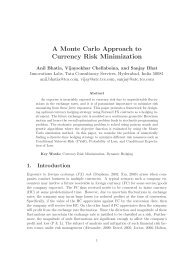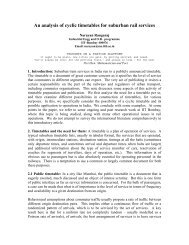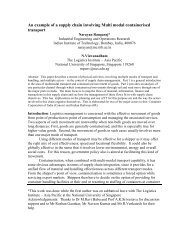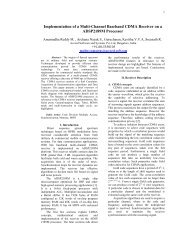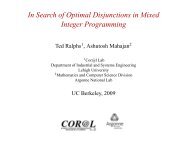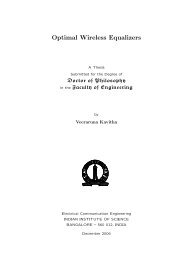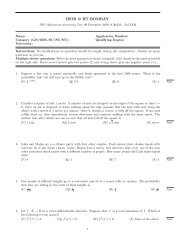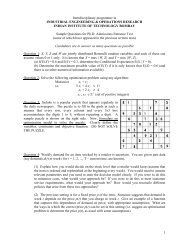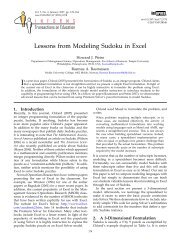Opportunistic Scheduling in Cellular Systems in the Presence of ...
Opportunistic Scheduling in Cellular Systems in the Presence of ...
Opportunistic Scheduling in Cellular Systems in the Presence of ...
You also want an ePaper? Increase the reach of your titles
YUMPU automatically turns print PDFs into web optimized ePapers that Google loves.
1764 IEEE TRANSACTIONS ON INFORMATION THEORY, VOL. 58, NO. 3, MARCH 2012<br />
and <strong>the</strong> correspond<strong>in</strong>g true utility adaptation (<strong>the</strong> actual utility<br />
obta<strong>in</strong>ed by <strong>the</strong> user) is given by<br />
(24)<br />
with <strong>the</strong> <strong>in</strong>itialization .<br />
Us<strong>in</strong>g <strong>the</strong> assumptions A.1-A.3 orA.1 and A.4, and us<strong>in</strong>g<br />
Lemma 3 <strong>of</strong> Appendix C-D, <strong>the</strong> policy can be analyzed <strong>in</strong><br />
exactly <strong>the</strong> same way as we analyzed . As a first step it is<br />
approximated us<strong>in</strong>g <strong>the</strong> ODE system<br />
(25)<br />
(26)<br />
with <strong>the</strong> <strong>in</strong>itializations .<br />
However <strong>in</strong> contrast to <strong>the</strong> previous section, <strong>the</strong> question <strong>of</strong><br />
uniqueness and stability <strong>of</strong> <strong>the</strong> attractor for <strong>the</strong> new ODE system<br />
rema<strong>in</strong>s open. Step 1 <strong>of</strong> <strong>the</strong> previous section, but without <strong>the</strong><br />
time limit<strong>in</strong>g argument, holds for any (s<strong>in</strong>gle po<strong>in</strong>t) attractor<br />
<strong>of</strong> <strong>the</strong> new ODE system. Similarly Step 2 and fur<strong>the</strong>r remarks<br />
on <strong>the</strong> properties <strong>of</strong> <strong>the</strong> attractors also hold for <strong>the</strong> new ODE<br />
system. The analysis would be complete if it can be shown that<br />
under truthful strategies, i.e., , <strong>the</strong> new ODE system has a<br />
global asymptotically stable, and hence unique, attractor. This<br />
would <strong>the</strong>n show that <strong>the</strong> time limits <strong>of</strong> <strong>the</strong> utilities are <strong>in</strong>deed<br />
given by <strong>the</strong> components <strong>of</strong> <strong>the</strong> attractor. While numerical results<br />
(given <strong>in</strong> <strong>the</strong> next subsection) support this on <strong>the</strong> examples<br />
studied, a pro<strong>of</strong> rema<strong>in</strong>s elusive.<br />
B. Examples<br />
We start this section with an example that re<strong>in</strong>forces our<br />
observation that ODE attractors are good approximations for<br />
time limits <strong>of</strong> almost all trajectories, under <strong>the</strong> true utility<br />
adaptations (13) or (24). In Fig. 1, we consider an example<br />
with two statistically identical and cooperative mobiles. Let<br />
represent <strong>the</strong> density <strong>of</strong> <strong>the</strong><br />
Rayleigh distributed random variable . The channel ga<strong>in</strong>s<br />
<strong>of</strong> <strong>the</strong> two mobiles are conditional Rayleigh distributed,<br />
i.e., for both ,wehave<br />
The utilities as before are <strong>the</strong> achievable rates<br />
. We plot two <strong>in</strong>dependent trajectories (sample paths) <strong>of</strong> <strong>the</strong><br />
two mobiles,<br />
<strong>in</strong>itialized away from <strong>the</strong>ir cooperative<br />
shares; <strong>the</strong> <strong>in</strong>itial values are set to .<br />
We set . Fig. 1(a) is for <strong>the</strong> policy (22) while<br />
Fig. 1(b) is for <strong>the</strong> policy (9). All <strong>the</strong> trajectories converge<br />
close to <strong>the</strong> attractors <strong>of</strong> <strong>the</strong> ODE thus corroborat<strong>in</strong>g <strong>the</strong>ory.<br />
We present ano<strong>the</strong>r example <strong>in</strong> Fig. 2 to illustrate <strong>the</strong> robustness<br />
and comparison <strong>of</strong> both <strong>the</strong> BS policies. Here too we consider<br />
two statistically identical mobiles, but now with<br />
Fig. 1. Time limits. For both policies ^ and , <strong>the</strong> ODE attractors (cooperative<br />
shares <strong>in</strong> this case) approximate <strong>the</strong> time limits <strong>of</strong> <strong>the</strong> adaptations (13) and<br />
(24). This is demonstrated via two <strong>in</strong>dependent set <strong>of</strong> trajectories (thick l<strong>in</strong>es<br />
form one set while <strong>the</strong> th<strong>in</strong> ones form <strong>the</strong> o<strong>the</strong>r set). Each set has two trajectories<br />
correspond<strong>in</strong>g to <strong>the</strong> true utility adaptations f<br />
g ;m =1; 2 <strong>of</strong> <strong>the</strong><br />
two mobiles. The cooperative shares for both mobiles are equal and <strong>the</strong> dotted<br />
straight l<strong>in</strong>es <strong>in</strong> both <strong>the</strong> figures represent <strong>the</strong> common cooperative share. (a)<br />
Policy ^ . (b) Policy .<br />
The first mobile can be noncooperative with<br />
. We consider <strong>the</strong> policy <strong>in</strong> Fig. 2(a) and (c) and <strong>the</strong> policy<br />
<strong>in</strong> Fig. 2(b) and (d). In (a)-(b), we plot trajectories correspond<strong>in</strong>g<br />
to cooperative behavior ( ) while <strong>the</strong> curves <strong>in</strong><br />
(c)-(d) are for <strong>the</strong> case when <strong>the</strong> first mobile is noncooperative<br />
with and with .<br />
All <strong>the</strong> cooperative curves [Fig. 2(a) and (b)] converge towards<br />
<strong>the</strong> cooperative share (which is <strong>the</strong> same for both <strong>the</strong> mobiles<br />
because <strong>the</strong>y are statistically identical). The true utility <strong>of</strong><br />
<strong>the</strong> noncooperative mobile (mobile 1) under both <strong>the</strong> BS policies<br />
converges to a value less than <strong>the</strong> cooperative share; thus<br />
confirm<strong>in</strong>g <strong>the</strong> <strong>the</strong>ory <strong>of</strong> <strong>the</strong> previous sections. However, <strong>the</strong>re<br />
are two important differences <strong>in</strong> <strong>the</strong> behavior <strong>of</strong> <strong>the</strong> two policies<br />
under noncooperation. 1) The utility <strong>of</strong> <strong>the</strong> noncooperative mobile<br />
(th<strong>in</strong> dash l<strong>in</strong>es) under policy [which is close to 0.41 <strong>in</strong><br />
Fig. 2(c)] is lesser than that under policy [which is close to<br />
0.45 <strong>in</strong> Fig. 2(d)]. Of course, both are less than <strong>the</strong> cooperative<br />
shares. 2) The utility <strong>of</strong> <strong>the</strong> cooperative mobile (that <strong>of</strong> mobile<br />
2, given by thick l<strong>in</strong>es) under policy is closer to its cooperative<br />
share, but is close to zero under <strong>the</strong> policy .<br />
We conclude this section with ano<strong>the</strong>r example <strong>in</strong> Fig. 3 to<br />
illustrate fur<strong>the</strong>r properties <strong>of</strong> both policies. The sett<strong>in</strong>gs <strong>of</strong> this<br />
figure rema<strong>in</strong> same as that <strong>in</strong> Fig. 1, except that we now use<br />
<strong>the</strong> Rayleigh random variable for channel amplitude<br />
ga<strong>in</strong>. We see that <strong>the</strong> more a mobile deviates from cooperative<br />
behavior, <strong>the</strong> more it loses. This is clearly visible under both<br />
policies, as <strong>the</strong> limit <strong>of</strong> <strong>the</strong> true utility <strong>of</strong> <strong>the</strong> noncooperative<br />
mobile deviates most from its cooperative share when .<br />
Fur<strong>the</strong>r, <strong>the</strong> policy penalizes <strong>the</strong> deviant mobile more than<br />
<strong>the</strong> policy , and hence is more robust.<br />
Simulation results showed that <strong>the</strong> reported rate trajectories<br />
[see (9)] and (22) tend to <strong>the</strong> cooperative shares<br />
much faster than <strong>the</strong> true rate trajectories. They however are not<br />
relevant and are not presented. In Fig. 1, <strong>the</strong> step sizes are larger



